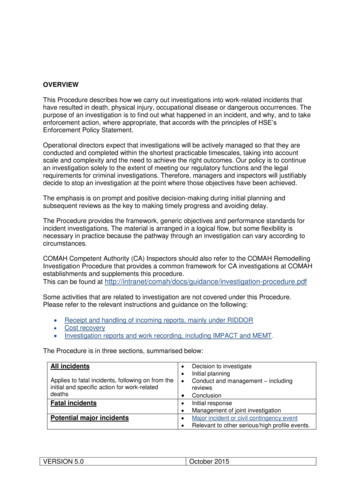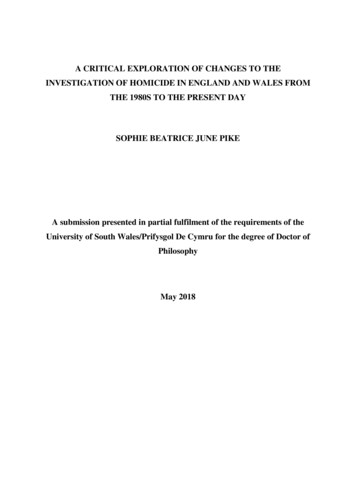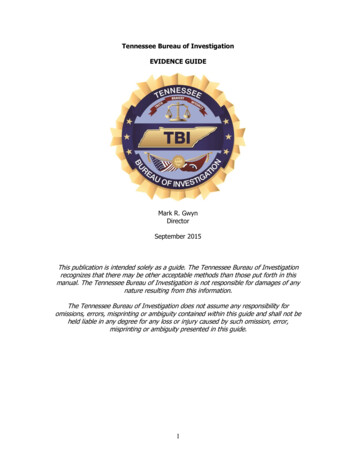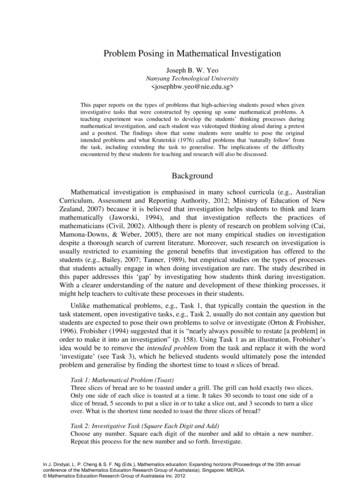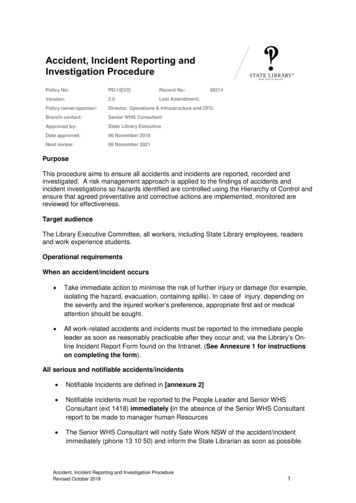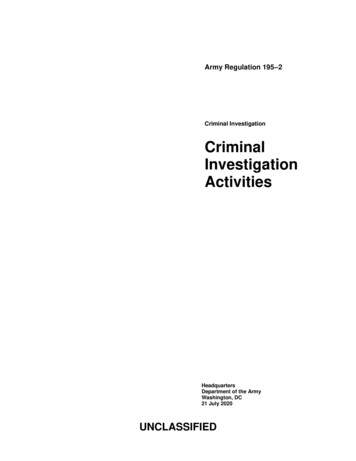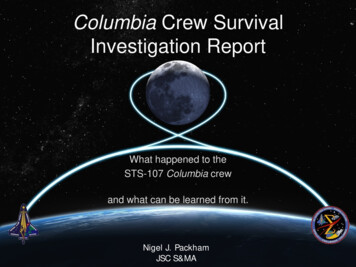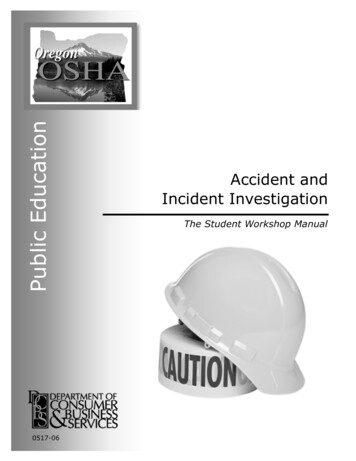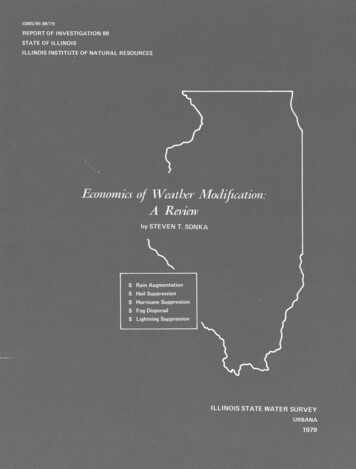
Transcription
REPORT OF INVESTIGATION 89Economics of Weather Modification:A Reviewby STEVEN T. SONKATitle: Economics of Weather Modification: A ReviewAbstract: This report first discusses gross benefits and costs of potential weather modificationactivities and the elements vital to a credible economic analysis of such activities. It then reviewsand evaluates more than 60 existing studies relating to the economic impacts of five major modification activities: precipitation augmentation including snowpack enhancement, hail suppression,hurricane suppression, fog dispersal, and lightning suppression. Because weather can have severeadverse effects on economic activity, gross benefits of modification appear very high in relationto most operational costs. However, indirect costs may be great and, in general, those adverselyaffected are not the same individuals enjoying the gross benefits. A credible economic analysisof net bcnefits of weather modification requires consulting with atmospheric scientists to assureunderstanding of the physical factors involved, funding for a considerable amount of data gathering,considering effects of possible future changes in crucial factors, and orienting the analytical viewpoint to both negative and positive regional economic impacts. Most of the existing literature relating to the economics of weather modification addresses precipitation augmentation and hail suppression; very few attempts toward comprehensive economic analyses have been made. More isknown about the economic impacts of weather on agriculture than for any other activity area.Reference: Sonka, Steven T. Economics of Weather Modification: A Review. Illinois State WaterSurvey, Urbana, Report of Investigation 89, 1979.Indexing Terms: Cloud seeding, cost-benefit analysis, economic impacts, fog dispersal, hail suppression, hurricane suppression, lightning suppression, precipitation augmentation, snowpack enhancement, weather modification.
STATE OF ILLINOISHON. JAMES R. THOMPSON, GovernorINSTITUTE OF NATURAL RESOURCESFRANK H. BEAL, M.U.P., DirectorBOARD OF NATURAL RESOURCES AND CONSERVATIONFrank H. Beat, M.U.P., ChairmanThomas Park, Ph.D., BiologyH. S. Gutowsky, Ph.D., ChemistryStanley K. Shapiro, Ph.D., ForestryLaurence L. Sloss, Ph.D., GeologyJohn C. Guyon, Ph.D.,Southern Illinois UniversityWilliam L. Everitt, E.E., Ph.D.,University of IllinoisSTATE WATER SURVEY DIVISIONWILLIAM C. ACKERMANN, D.Sc, ChiefURBANA1979Printed by authority of the State of Illinois(8-79-1000)
CONTENTSPAGEIntroductionOrganization of this effortAcknowledgmentsEconomic effects of weather modificationGross benefits and modification costsExternal effectsImportant factors for economic analysis of weather modificationPrecipitation augmentationSummertime augmentationEffects on agricultureWeather effects on other sectors of the economyOutdoor ater suppliesFall rainfall augmentation of Great LakesSnowpack augmentationHail suppressionEstimates of crop lossesProperty damage due to hailIndividual farmer and hail suppressionEstimates of the adoption of hail suppressionNational and regional economic impactGains to crop producersBenefit/cost ratiosMajor storm (hurricane) suppressionFog dispersalLightning suppressionSummaryPrecipitation augmentationHail suppressionMajor storm suppressionFog dispersalLightning 61717192126262627323235363944464747495051515153
Economics of Weather Modification:A ReviewSteven T. Sonka*INTRODUCTIONTwo types of benefits are potentially available from efforts to modify the weather(Sewell, 1969). The first is to reduce losses from the occurrence of weather events. Hailstorms, hurricanes, lightning, and drought are some examples of weather phenomenawhich can cause severe losses. A second type of benefit arises when alteration of a particular weather factor can increase production of a desired good. Additional precipitation for crop production and power generation is an example of such a production consideration. Weather modification to produce either of these benefits could generatesocietal benefits.A major problem in conducting an economic evaluation of weather modificationtechnology arises from uncertainty about performance of the technology itself. As notedby Haragan (1974) considerable scientific controversy exists regarding the degree towhich weather modification is thought to be successful. Haragan lists four questionswhich he feels must be answered before any cloud seeding effort should be undertaken.(These can easily be extended to other forms of weather modification.) These questionsare paraphrased as:1)2)3)4)Should it take place?If so, how can a potential seeding opportunity be recognized?How should a recognizable cloud be treated?What did the seeding accomplish?The first question is not entirely a physical question. Here, a complete set ofphysical, economic, legal, social, political, and moral factors must interact to reach abeneficial decision. This paper does not attempt to describe any of the non-economicvariables alluded to, not because they are unimportant, but because of inadequate resources for their consideration here.The second, third, and fourth questions relate to physical factors and measuresof such factors. The unanswered questions diminish the outlook for general acceptanceof cloud seeding. Haragan further notes that the public, not just the scientific community, must be confident of the answers to these questions.Harmon (1976) details strong concern regarding the potential both to beneficially alter the weather and to assess those physical effects which result. He stressesthat a dependable method of a cloud seeding must include a method to determine themodification potential of a cloud system and a technology to liberate this potential.He implies that sufficient understanding of clouds is not available to satisfy these twoconditions. He also notes the difficulty of obtaining support for long-term experimentswithout a guarantee of certain social or societal benefits from successful research projects.* Assistant Professor of Agricultural Economics, University of Illinois, Urbana.1
But identification of physical effects is not the only potential problem in conducting an economic analysis. A second set of problems relates to the identificationand quantification of the costs and benefits associated with weather modification. Itis this second set of problems to which this report is addressed.Organization of This EffortThe goal of this research effort is to review the existing literature dealing withthe economics of weather modification and to delineate concerns which should be incorporated into future economic analyses. This effort is organized as follows: First,a general discussion of the costs and benefits of weather modification is presented.Second, several factors which are vital to the successful completion of an economicanalysis of weather modification are discussed. The remainder of the report is a literature review of each of five main types of weather modification: precipitation augmentation (including snowpack enhancement), hail suppression, major storm suppression,fog dispersal, and lightning suppression.AcknowledgmentsThe original research for the effort leading to this report was funded largelyunder Contract 7-14291 from the National Oceanic and Atmospheric Administrationof the Department of Commerce. The author wishes to commend the efforts ofR. L. Lavoie of that agency and the members of the National Weather ModificationAdvisory Board for perceiving the need for such research. Also the continuing supportof the Illinois Agricultural Experiment Station is appreciated. The assistance of J. Gutman,former research assistant in the Department of Agricultural Economics, in preparing thefinal version of this report is gratefully acknowledged.The input of the Illinois State Water Survey was instrumental in the preparation of this document. Stanley A. Changnon, Jr., played a major role in conceptualizingthe effort and critically reviewing the report. J. L. Ivens edited the final manuscript andM. J. Innes prepared the camera copy. The relevance of the material to weather modification research in Illinois led to its publication by the Water Survey.ECONOMIC EFFECTS OF WEATHER MODIFICATIONFew studies have extensively addressed the economic aspects of weather modification. What are the costs and benefits? Only when that is known can responsibledecisions be made.Gross Benefits and Modification CostsWeathercausedlosses2To help set the potential benefits in perspective, a few estimatesof weather-caused losses in the United States are presented intable 1 for broad categories of national activities (Thompson,1976). These dollar losses and the percentage they represent ofthat sector's annual gross revenues indicate that agriculture has
by far the greatest stake in weather modification.Note. The term "losses" is used with great trepidation. Certainly this usageis not consistent with Russell's comment, ". . .that loss measurementsmust bear some relation to intended action in order to be meaningful"(1968, p. 624). However, these estimates are used here to provide acrude indication of the magnitude of economic costs resulting from adverse weather events on particular economic sectors.Weather losses can also be viewed by types of weather. Hendrick and Friedman(1966) estimate the ranges of insured property losses in the nation as given in table 2.Latest calculations of hail losses in the U.S. show 773 million for crops and 75 million for property (Changnon et al., 1977). Fog causes an estimated loss of 70 million to the aviation industry (Tschupp, 1970).More is known specifically about the economic impacts of weather on agriculture than for any other activity area. For example, specific crop yield reductions dueto all forms of weather hazards appear in table 3 (Changnon, 1972). These data demonstrate the regional differences in losses for two major crops and also the generalimportance of rainfall, either too little or too much.In general, the gross benefits from the utilization of effective weather modification techniques appear very large. In some cases, however, these gross benefits wouldbe considerably offset by direct and indirect costs. Although these costs are detailedlater in this report, the reader should keep this caution in mind when evaluating theTable 1. Annual Weather Caused Losses in the United Statesand Percent of Annual Gross RevenueLosses(millionsof dollars)ActivityAgricultureCommercial AviationConstructionManufacturingTransportation (rail, highway, water)CommunicationsElectrical PowerEnergy Fossil FuelsOther (general public, government, etc.)TotalPercent of that sector'sgross .30.20.12.012,684Table 2. Annual Insured Property Lossesdue to Weather in the United StatesRange (millions of dollars)HurricanesThunderstorms (lightning,hail, and winds)TornadoesWindstorms 0500to10003
Table 3. Annual Estimated Corn and Soybean Yield Losses due toVarious Weather Conditions in the Midwest Corn Belt AreaAverage annual loss(bu/acre)Western Corn Belt(Nebraska, Western eFreeze ormoistureheatcoolnessfrostTotal lossTotal as percent of total yieldSoybeansCentral Corn Belt(Eastern Iowa, s1.40.92.72.61.10.40.49.531Eastern Corn Belt(Indiana, 1.70.70.426.53611.438gross benefit estimates of the next few paragraphs. Also the benefit figures presentedwere not estimated for the same year. Because of the relatively substantial inflationrates of the past few years, the reader should note that a dollar estimate for the 1960smight be considerably higher if converted to a current dollar basis.One of the most carefully developed estimates of the economicbenefits of very successful future weather modification (80%reduction in hail with 16% increase in growing season rainfall)shows that by 1995, with wide usage in the western UnitedStates, the benefit in reduced food costs would be 890 million(Changnon et al., 1977). Notably, this would be only a 5% reduction in farm production costs of food. The benefits from a lesser but still optimistic modificationcapability (—54% to hail, 9% in rain) would produce only a 2% reduction in production costs. These estimates include a careful analysis of the direct operating costsassociated with the technology.EconomicbenefitestimatesA recent report of the National Academy of Science (1976) presented cropyield and forage increases resulting from a modest (10%) increase in precipitation overlarge areas of the nation. The direct benefits in the form of farm receipts would be 217 million yearly, but this estimate does not account for any costs. A 5% increasein precipitation in the Connecticut River Valley (over 9 months) would produce costadvantages (those gained in relation to the next best alternative) of 1.3 million because of increased water for domestic and industrial users (Aubert et al., 1972).One estimate of the benefits from hurricane modification (20% wind reductionwith no rain change) showed 100 million gained annually in the United States and 800 million globally (Gray, 1973). These reductions represent benefit/cost ratiosranging from 30/1 up to 60/1.The average annual increase in the runoff of a California (Sierra) river basin,due to snowpack enhancement conducted over a 19-year period, was estimated at67,300 acre-feet of water, a 4% increase (Williams, 1971). This added water has localvalues ranging from 340,000 yearly (irrigation costs of water) up to 1.3 million (a4
maximum for certian power generation considerations). Operational costs averaged 51,000 annually, yielding benefit/cost ratios of 6.6/1 up to 25/1, depending on thevalue (use) of the water. If potential costs for evaluation and monitoring are included,the benefit/cost ratios drop, ranging from 1.8/1 up to 7/1.An extensive assessment of the potential enhancement of winter snowpackin the Colorado River Basin considered three economic outcomes against an annualcost of 9.5 million (Weisbecker, 1974). If no new water resource managementfacilities were built, the benefits (from a predicted 2 million acre-feet of added water)would be 12.8 million. Two other alternatives, based on different assumptions aboutthe construction of new basin facilities, revealed in one case a benefit of 30 millionand in the other case no benefits.It is instructive to consider some of the benefit/cost ratios available from the more thorough economic studies of weather modification. The range offered represents differences due to differentmodification capabilities and economic valuations. For the simultaneous decrease in hail and increase in rain, the ratios varied from1/1 up to 15/1; for added snowpack in the Colorado Basin they were 1/1 to 3/1; andfor added snowpack in the Sierras they varied from 1.8/1 to 25/1. The less certain calculations for hurricane winds modification produced ratios from 30/1 up to 60/1. Itis important to realize that the range of values for ratios is great, as is the diversity ofunderlying assumptions used in determining those estimates.Ratios ofbenefitsto costWeather-related losses occurring in the nation are often catastrophic and smallpercentage reductions in damages from major storm events would reap substantialrewards. For the more minor events, such as closing of a particular airport due to fog,annual benefits could also be sizeable with a benefit/cost ratio of 5/1 (Beckwith, 1966).The gross benefits of weather modification efforts appear evenmore attractive when compared with the associated modification(operational) costs. For rain and hail modification, 1 per acrecan be considered as a reasonable cost estimate involving operations, evaluation, and informational services (Changnon et al.,1977). This compares with other non-land production costs of 40 to 50 per acrefor wheat in the Great Plains. Additional water from snow augmentation in the western mountains is expected to cost 1 to 1.50 per acre-foot (Weisbecker, 1974). Thiscould be compared to costs of 50 per acre-foot for providing additional water by interbasin transfers (Howe and Easter, 1971). Only in the case of hurricane suppressiondo operational costs ( 10 to 20 million per hurricane) attain significant levels (Gray,1973). But as noted in table 2, damages in these storms are correspondingly large.Cost ofweathermodificationEvaluation of only the gross benefits and costs suggests that particular economicsectors would be quite interested in weather modification. In general, those sectorsmight be expected to be concerned only with the trade-off between gross benefitsand operational costs. If the desired weather modification technology is not consideredsufficiently efficient, then those interested sectors might support research and development of that technology. Although such research might be complex and relatively costly,these interested user sectors would see the expectation of future benefits — especially ifthat research and development were conducted in the public sector.5
External EffectsA major flaw exists in the process of comparing gross benefits and modification costs, one which is not corrected by the addition of expected research costs.This flaw arises when the external effects of a weather modification program are notconsidered. This is not really an oversight for the private sector affected; rather, theproblem arises when public sector monies are involved.As Castle and Stoevener suggest (1966), disbenefits as well asDisbenefitsbenefits can result from a purposeful effort to alter weather.as well asOne instance where a loss rather than a benefit occurs is whenbenefitsthe intended physical change does not occur. The WhitetopExperiment in Missouri is an example of this concern. Deckeret al. (1971) note that the initial analysis of this project indicated that precipitationin the target area was decreased rather than increased by augmentation efforts. Theseauthors report a more sophisticated analysis which indicated that the seeding may havehad no effect on rainfall. But the potential of decreased rainfall was not disproved,either.Two external economic effects are especially important. One hasto do with effects in areas other than the area intended for modification. An example is a snowpack augmentation program whichresults in considerably greater snowfall in the cities downwind ofthe intended region. The costs of additional snow removal anddisruption of transportation in an urban area may be significant enough to be consideredin an overall evaluation of the augmentation effort. A potentially more serious illustration involves the possibility of a hurricane with altered path. Although people in theoriginal path may have considerable benefit from reduced damages, those people in thealtered path area suffer considerable harm.Effects inunintendedareasA second type of external economic outcome concerns the diversity of weather needs within a modification region (Changnon,1975). For example, additional water from Rocky Mountainsnowpack augmentation may be beneficial for irrigation, powergeneration, and municipal uses in the Lower Colorado River Basin.But that additional snowfall may harm transportation, mining, and recreation activitiesin the Upper Colorado River Basin. It would seem that those individuals negatively affected in the Upper Basin might desire compensation from the sectors benefiting in theLower Basin. This desire could lead to considerable controversy even for a program forwhich positive net benefits could be demonstrated.DiverseweatherneedsIn another example, in some parts of South Dakota both wheat and corn production are major activities. For wheat production, more rainfall than would normallyoccur in the spring months is beneficial. However, this same additional rainfall is detrimental to corn planting and hence production. A reverse relationship with rainfall isnoted for these same two crops with respect to rainfall in July. This is an interestingexample because in some areas individual farmers may grow both crops and, therefore,given adequate information, be able to choose (on some collective basis) if attempts toaugment rainfall would be beneficial. In other situations, production of the two cropsmight tend to be so specialized that a potential for economic conflict is more likely(Changnon, 1975).6
The crop production example above was interesting because competing waterneeds occurred in the same region and economic sector. However, in the cash-graincrop production regions of Illinois, both corn and soybean production are favorablyimpacted by additional July rainfall (Huff and Changnon, 1972). But non-agriculturalendeavors may not desire additional summer precipitation. Among these are outdoorconstruction and recreation activities, both heavily affected by weather (see table 1).One positive attribute of all types of weather modification is itsreversibility, in a technical sense. Once a particular storm is modified it is not possible to undo the effects on that storm, but theredoes not appear to be any evidence that future storms will be affected. The seemingly independent nature of weather modificationis attractive when considered as an alternative for major projects with long lasting effects(e.g., construction of canals for interbasin water transfers). In addition, present andforeseeable weather modification systems are quite mobile and can be installed or removed quickly and do not require sizeable in-place l reversibility does not insure that weather modification programs canbe turned off and on easily within a social context, however. If some economic sectorsare benefited by use of a modification technology, those benefits are quite likely to bebid into the value of the fixed assets associated with that sector. Therefore, efforts toterminate the modification program would cause losses to the owners of those assetsand could be expected to lead to controversy.A major factor affecting the economic benefits of weather modifiNatural andcation, which has only infrequently been analyzed, is that of varitechnicalability. Two types of variability are potentially relevant. One isvariabilitiesthe naturally occurring fluctuations of the weather event in question.The other is variability in the performance of the technology. Bothof these factors can have an impact on economic benefits.Although crop producers may believe a 20% increase in summer rainfall is advantageous, the expected benefit from that augmentation program may not be thesame as the yield benefit calculated by measuring the impact of 120% of the averagerainfall. In dry years, the 20% increase may have considerable yield-increasing effectsor the additional rainfall may be so slight (20% of nothing is nothing) that the effect isnot really measurable. Alternatively, if the augmentation program increased rainfall ofa single thunderstorm from 2 to 3 inches, yield gains may not occur as the additionalinch of water is lost as runoff. Indeed, for farmers in low lying areas such additionalrunoff may depress yields.Variability in the performance of the technology, for example securing a 40%decrease in hail on one day and none on the next, is a major concern for assessing theeconomic potential of weather modification. Unfortunately, however, the presentstate of the modification science does not allow for its specification.An additional economic ramification relates to public responsesNegationto successful modification. Because weather modification is oftenby publicconcerned with phenomena with major impacts, alteration of someresponsesbehavior patterns of people might be expected. The potential ofreducing building expenditures if hurricane suppression is successful is an example of such behavioral change. But hurricane suppression does not insure7
that tremendously destructive hurricanes will not occur. Even if all major storms couldbe reduced by some sizeable percentage, it is conceivable that, if buildings and structureswere less well-built, similar amounts of damage would result as if no suppression existedand greater construction expenditures had been made. Thus economic benefits resultingfrom given shifts in average weather may be negated with time and the actions of affectedpeople.Although this last example might be an extreme case, it illustrates that claims ofbenefits from weather modification must be evaluated closely. Complete assessmentsof future benefits of weather modification programs must consider such secondary responses and their effects.Important Factors for Economic Analysis of Weather ModificationA number of factors are especially important for anyone contemplating a comprehensive analysis of the net benefits associated with a particular application of aweather modification technology.For three reasons, close consultation and cooperation with atmospheric scientists is essential. First, their assessment of whichphysical phenomena will be altered by the modification processis crucial. This list of factors must not be limited only to thosefactors thought to be beneficial. For example, if the rainshadoweffect is a likely possibility, then it, as well as the beneficial rainfall effects, should benoted.ConsultphysicalscientistSecondly, their information is needed regarding the two types of variabilityin weather modification, that due to uncertain technological performance and thatdue to natural weather fluctuations. The economist needs to have both the possiblerange of outcomes for the delineated physical factors and the likelihood functiondescribing the relative probabilities associated with each possible outcome. As shownby Huff and Changnon (1972) for corn and soybean production, consideration ofthese variability factors can result in evaluations of a technology which are positivein some years but negative in others. Development of this type of information isessential if decision-makers are to formulate knowledgeable opinions.The third type of data needed from the physical scientist is a listing of relevantaspects regarding the modification process. Such variables as when in the day, or inthe year, such modification is possible are important factors to consider for precipitation enhancement. If the physics of storm clouds means that certain regions are more'seedable' than others such information can be very valuable to set parameters aroundthe range of economic analysis needed.After consultation with atmospheric scientists, the next mostcrucial feature of an economic analysis is its viewpoint. Toomany existing studies have embodied the orientation "If weundertake this modification to benefit sector A, what exactlyare the benefits to sector A?" The proper question is "If thismodification process alters the weather in region X, what will be the impacts, bothpositive and negative, on the economy of region X?"Analyticalviewpointimportant8
This latter orientation implies a considerable amount of additional effort.And to do the job well, such studies should be restrained to carefully conducted regional analyses. The proper size of the regions will be dictated in large measure bythe information supplied by the physical scientist.If a regional analysis is undertaken, it is important to clearly distinguish thenet regional and the net national benefits. This is especially true if national researchmonies are involved. The reason is that a portion of projected regional gains is likelyto be in the form of income transfers from other regions (Crutchfield, 1973). Suchtransfers should be specified so that national policymakers can be made aware ofany unintended regional effects. This concern would seem particularly crucial whensecondary benefits associated with proposed programs are being considered.Regional gains should be presented, however. It seems plausible that nationalpolicymakers might think it proper to support a program in order to enhance development in a particular region. And policymakers in the affected regions would surelyfind information on both positive and negative potential effects to be of considerableinterest.Although it is important to know if a potential technology wouldbe valuable under today's conditions, this knowledge is less usefulwhen those conditions change. Therefore the role of potentialchanges in the economic environment in which the technologywill perform is important. This does not mean the analyst shouldconsider all possible societal changes and describe their impact on the value of the technology in question. Rather, the analysis should center on crucial factors and describethe impacts of changes in these variables.PotentialeconomicchangesFor example, in snowpack enhancement, the level of demand for agriculturalproducts and for energy has a major impact on the value of the augmented water.Therefore, it would be extremely valuable to know the potential value of snowpackaugmentation under conditions of both low and high demand for these commodities.Users of the analysis could then evaluate the technology for the currently relevantdemand level.An often overlooked feature of economic analyses is that a properBasicresult will require a considerable amount of data gathering. Thisdatatype of research work is costly in terms of time and money and isgatheringoften tremendously tedious. But funding agencies which do notallow enough time and money for basic information generationare dictating that the probability of receiving a valuable comprehensive analysis isvery low.PRECIPITATION AUGMENTATIONThe prospect of augmenting precipitation has generated the greatest amountof economic study of th
Hail suppression 26 Estimates of crop losses 26 Property damage due to hail 26 Individual farmer and hail suppression 27 Estimates of the adoption of hail suppression 32 National and regional economic impact 32 Gains to crop producers 35 Benefit/cost ratios 36 Major storm (hurricane) suppression 39 Fog dispersal 44 Lightning suppression 46


